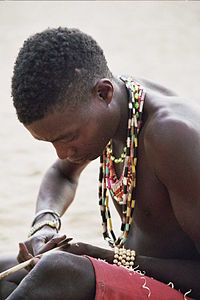Portal:Tanzania
 The Tanzania Portal
Tanzania, officially the United Republic of Tanzania, is a country in East Africa within the African Great Lakes region. It is bordered by Uganda to the northwest; Kenya to the northeast; the Indian Ocean to the east; Mozambique and Malawi to the south; Zambia to the southwest; and Rwanda, Burundi, and the Democratic Republic of the Congo to the west. Mount Kilimanjaro, Africa's highest mountain, is in northeastern Tanzania. According to the 2022 national census, Tanzania has a population of nearly 62 million, making it the most populous country located entirely south of the equator. Many important hominid fossils have been found in Tanzania, such as 6-million-year-old Pliocene hominid fossils. In the Stone and Bronze Age, prehistoric migrations into Tanzania included Southern Cushitic speakers who moved south from present-day Ethiopia; Eastern Cushitic people who moved into Tanzania from north of Lake Turkana about 2,000 and 4,000 years ago; and the Southern Nilotes, including the Datoog, who originated from the present-day South Sudan–Ethiopia border region between 2,900 and 2,400 years ago. These movements took place at about the same time as the settlement of the Mashariki Bantu from West Africa in the Lake Victoria and Lake Tanganyika areas. In the late 19th century, the mainland came under German rule as German East Africa, and this was followed by British rule after World War I when it was governed as Tanganyika, with the Zanzibar Archipelago remaining a separate colonial jurisdiction. Following their respective independence in 1961 and 1963, the two entities merged in 1964 to form the United Republic of Tanzania. Tanganyika joined the British Commonwealth and Tanzania remains a member of the Commonwealth as a unified republic. Tanzania is mountainous and densely forested in the north-east, where Mount Kilimanjaro, the highest mountain in Africa and the highest single free-standing mountain above sea level in the world, is located. Three of Africa's Great Lakes are partly within Tanzania. To the north and west lie Lake Victoria, Africa's largest lake, and Lake Tanganyika, the continent's deepest lake, known for its unique species of fish. To the south lies Lake Malawi. The eastern shore is hot and humid, with the Zanzibar Archipelago just offshore. The Menai Bay Conservation Area is Zanzibar's largest marine protected area. The Kalambo Falls, located on the Kalambo River at the Zambian border, is the second-highest uninterrupted waterfall in Africa. Tanzania is one of the most visited tourist destinations for safaris. Selected article -The Tanzania People’s Defence Force (TPDF) (Swahili: Jeshi la Ulinzi la Wananchi wa Tanzania) is the military force of the United Republic of Tanzania. It was established in September 1964, following a mutiny by the former colonial military force, the Tanganyika Rifles. From its inception, it was ingrained in the troops of the new TPDF that they were a people's force under civilian control. Unlike some of its neighbouring countries, Tanzania has never suffered a coup d'état or civil war. The TPDF's mission is to defend Tanzania and every Tanzanian, especially the people and their political ideology. Conscripts are obligated to serve 2 years as of 2004. (Full article...)General images -The following are images from various Tanzania-related articles on Wikipedia.
This month in Tanzanian history
Wildlife of Tanzania - Credit: yaaaay
The lion (Panthera leo) is one of the four big cats in the genus Panthera, and a member of the family Felidae. With some males exceeding 250 kg (550 lb) in weight, it is the second-largest living cat after the tiger. Wild lions currently exist in Sub-Saharan Africa and in Asia with a critically endangered remnant population in Gir Forest National Park in India. Did you know ...
CategoriesWikiProjectsRecognised contentSelected panorama -Moshi is a Tanzanian town with a population of 144,739 (2002 census) in Kilimanjaro Region. The town is situated on the lower slopes of Mt Kilimanjaro, a volcanic mountain that is the highest mountain in Africa. Moshi is home to the Chagga and Maasai tribes and lies on the A 23 Arusha-Himo east-west road connecting Arusha and Mombasa, Kenya. Just to the east of Moshi is the intersection with the B 1 north-south road eventually connecting with Tanga and Dar es Salaam.
Uganda–Tanzania War -Articles here focus upon aspects of the Uganda–Tanzania War. These are all Good articles that meet a core set of high editorial standards.
The Battle of Entebbe was a battle of the Uganda–Tanzania War that took place on 7 April 1979 on the Entebbe peninsula in Uganda between Tanzanian units and Ugandan and Libyan units. The Tanzanians occupied the area, killed hundreds of Libyans, and ended the Libyan airlift in support of the Ugandan government. Idi Amin had seized power in Uganda in 1971 and established a brutal dictatorship. Seven years later he attempted to invade neighbouring Tanzania to the south. The attack was repulsed, and Tanzanian President Julius Nyerere ordered a counter-attack into Ugandan territory. As Tanzanian forces advanced deeper into the country, Libya sent its own troops to support the Ugandans, flying them in to the airport at Entebbe. From their position in Mpigi the Tanzanians could see the Libyan air traffic, so they decided to attack the location to stop the airlift and eliminate a potential flank attack ahead of their assault on Kampala. (Full article...)TopicsSelected picture - Credit: Idobi
A Hadza man preparing arrow in Tanzania. The Hadza people live around Lake Eyasi and number less than 1000. 300–400 Hadza people still live as hunter-gatherers. ...Archive — Nominations
Related portalsThings you can doAssociated WikimediaThe following Wikimedia Foundation sister projects provide more on this subject:
Discover Wikipedia using portals | ||||









































































